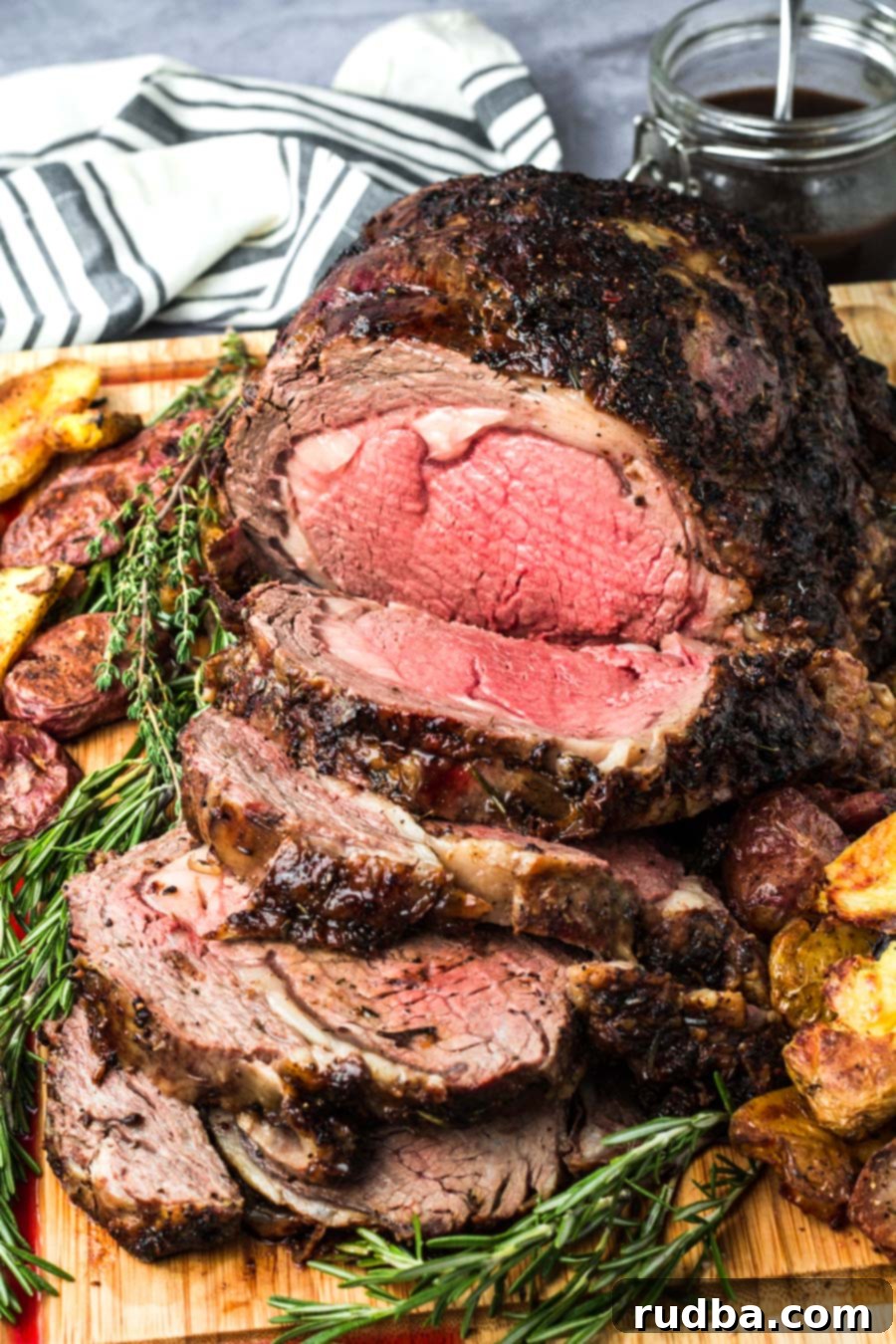Mastering the Perfect Medium Rare Prime Rib with Rich Au Jus: Your Essential Guide
Prepare to impress your family and friends with a show-stopping meal that’s both elegant and incredibly satisfying: a perfectly cooked medium-rare prime rib, complemented by a luscious, savory au jus. This recipe is designed to guide you through creating a tender, juicy beef roast, seasoned with a fragrant butter and herb mixture, resulting in a main course that’s ideal for any special occasion or a memorable Sunday dinner. Forget complicated techniques; with our clear steps, you’ll achieve restaurant-quality results right in your own kitchen.
While gourmet dinners often seem daunting, this impressive prime rib recipe proves they don’t have to be. Sometimes, you crave something a little more special than your usual quick weeknight meals. This is where a magnificent prime rib steps in, transforming an ordinary evening into an extraordinary culinary experience. Paired with classic sides like Creamy Mashed Potatoes or Cheesy Scalloped Potatoes, you’re not just making dinner; you’re orchestrating a feast that will delight everyone’s taste buds. Get ready to discover the secret to a truly unforgettable meal.
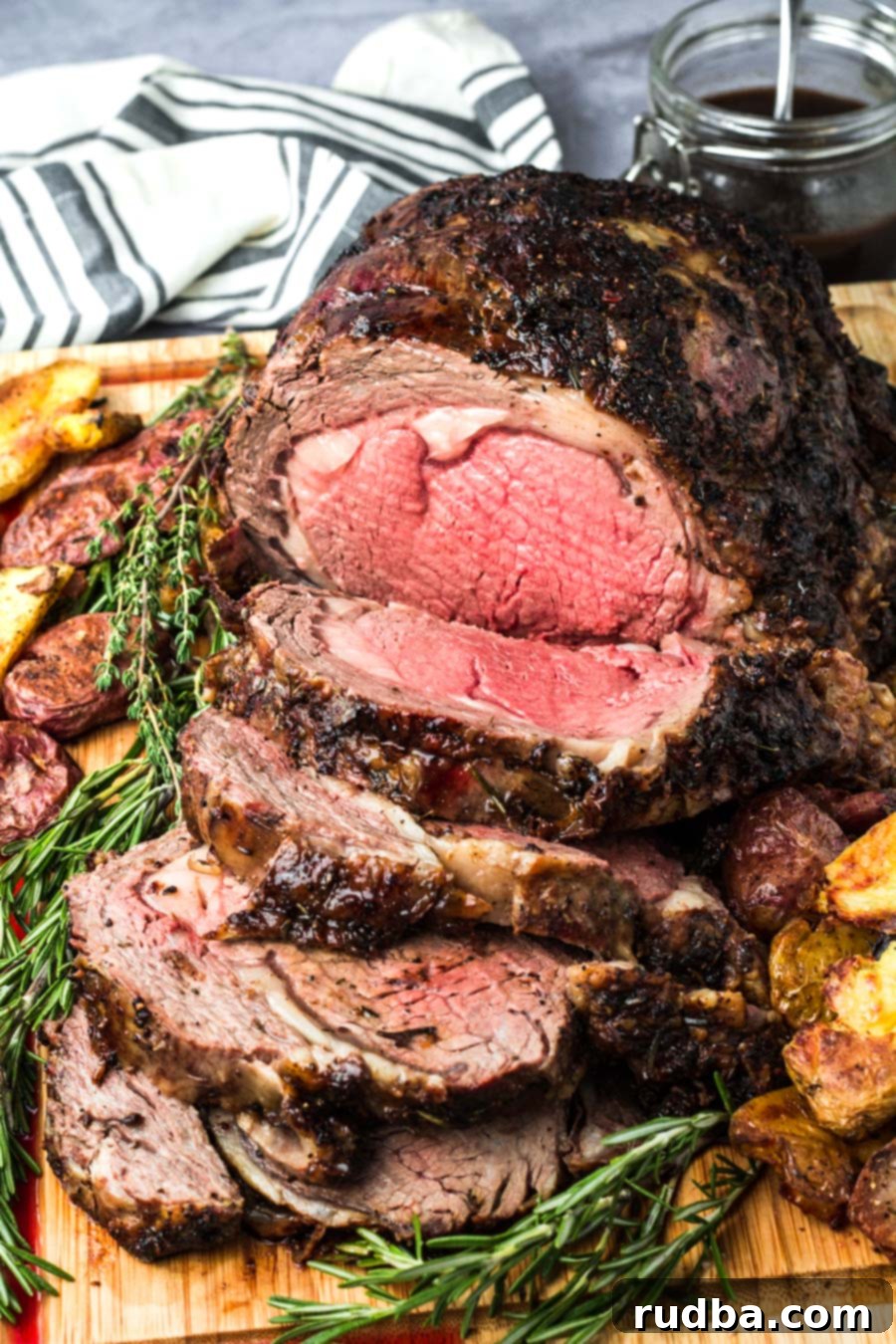
How To Make the Perfect Prime Rib
Creating an exquisite prime rib might sound intimidating, but it’s surprisingly straightforward with the right approach. Follow these steps for a tender, flavorful, and perfectly cooked roast every time.
- Prep the Roast – Begin by allowing your prime rib roast to rest on the counter for at least 30 minutes to an hour. This crucial step brings the meat closer to room temperature, ensuring a more even cook. While it rests, preheat your oven to a scorching 500 degrees F. If your prime rib has bones, it’s often a good idea to tie each rib with kitchen twine and wrap the ends of the bones with aluminum foil. This helps to prevent the bones from charring too quickly during the initial high-heat sear, ensuring they contribute their full flavor to the roast without burning.
- Craft the Herb Butter Rub – In a small bowl, combine softened unsalted butter with freshly minced garlic, aromatic fresh thyme, fragrant fresh rosemary, coarse salt, and freshly ground black pepper. Mix these ingredients thoroughly until you have a rich, herbaceous paste. This butter rub is the secret to a beautifully crusted and intensely flavorful exterior. Generously coat the entire rib roast with this mixture, ensuring every surface is covered for maximum flavor penetration.
- Cook to Perfection – Insert an oven-safe meat thermometer into the thickest part of the roast, making sure it doesn’t touch any bone. Place the prepared prime rib in a sturdy, deep roasting dish. Start by cooking the roast at 500 degrees F for 15 minutes. This high heat creates a beautiful crust. After 15 minutes, reduce the oven temperature to 325 degrees F. Continue roasting until the internal temperature of the meat is 5 degrees lower than your desired final doneness. For instance, if you’re aiming for medium-rare at 130 degrees F, remove it when it reaches 125 degrees F.
- Cover and Rest – This is arguably the most important step for a juicy prime rib. Once the roast reaches its target temperature, remove it from the oven and immediately wrap it loosely but securely in aluminum foil. Let it rest undisturbed for a minimum of 20 minutes, or even up to 30 minutes for larger roasts. During this resting period, the internal temperature will continue to rise (this is called carryover cooking), and the juices, which have been driven to the center during roasting, will redistribute throughout the meat, resulting in an incredibly tender and succulent prime rib. After resting, slice the meat against the grain for the most tender bite.
- Start the Au Jus Gravy – While the prime rib rests, turn your attention to the glorious au jus. Place a skillet over high heat on your stovetop. Add the flavorful pan juices from the roasting dish, along with any leftover roasted garlic halves (if you roasted extra, or the halves from your butter rub). Pour in the red wine, allowing it to deglaze the pan and scrape up any browned bits that are rich with flavor. Add about 2 ½ cups of beef stock. Bring this mixture to a rapid simmer, stirring occasionally, and let it reduce by half. This concentration of flavor is what makes an exceptional au jus.
- Finish the Gravy – Once the liquid has reduced, lower the heat. In a small bowl, whisk together the cornstarch with 1 tablespoon of water to create a slurry. Gradually add half of this cornstarch mixture to the simmering skillet, whisking constantly to prevent lumps. The sauce will begin to thicken. If you desire a thicker consistency, add the remaining cornstarch slurry, continuing to whisk until the au jus reaches your preferred thickness. Season with salt and pepper to taste.
- Serve and Enjoy! – Arrange the beautifully sliced prime rib on a platter. Generously pour the warm, rich au jus over each slice, allowing it to coat the tender beef. Serve immediately with your chosen side dishes and prepare for an unforgettable meal!

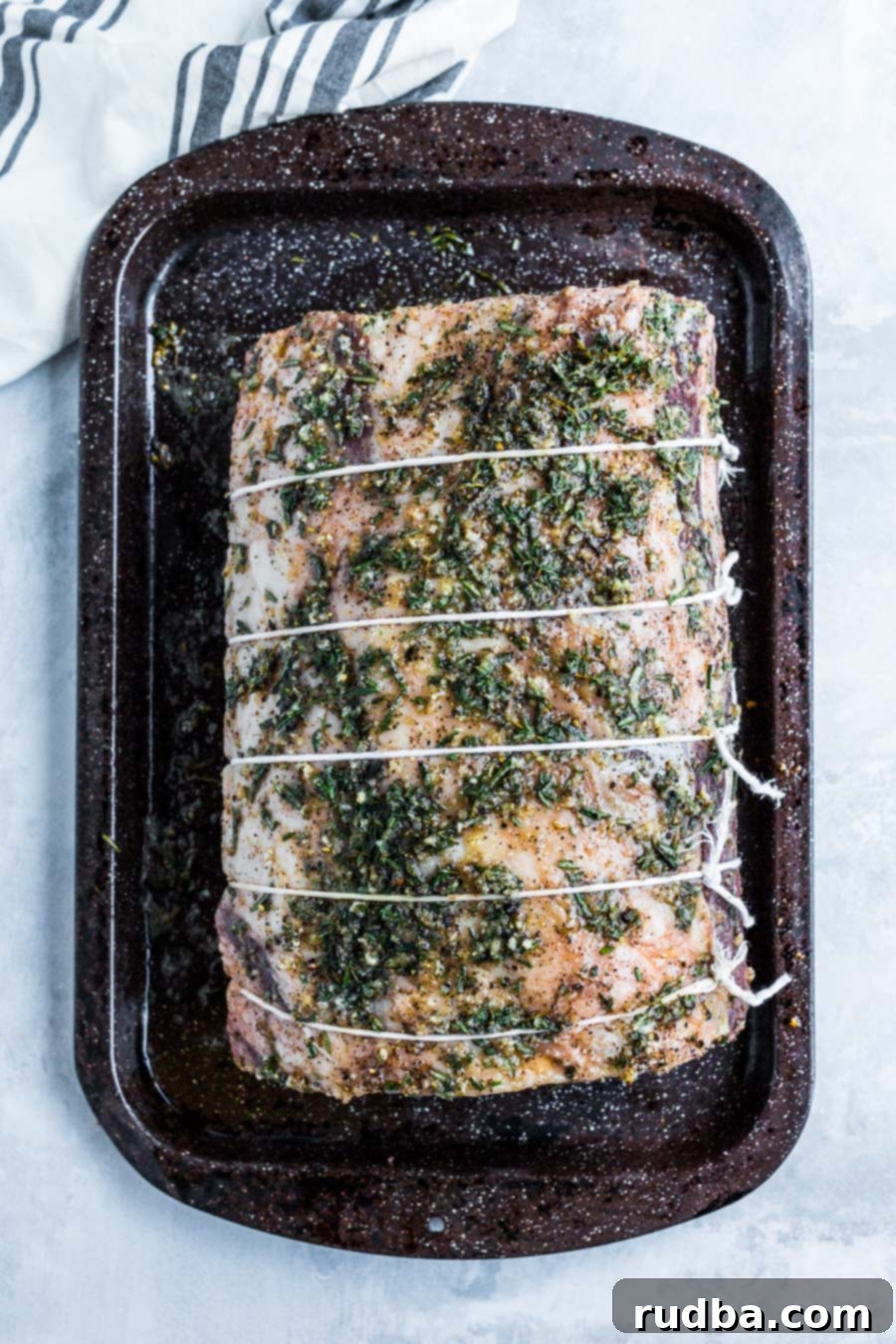
Tips and Variations for The Perfect Prime Rib with Au Jus
Even the most classic recipes can benefit from a few expert tips and creative variations. Here’s how to elevate your prime rib experience even further:
- Enhance with Au Jus or Enjoy Plain – While I highly recommend making the rich red wine au jus as it absolutely “skyrockets” the flavor and moistness of the prime rib, it’s perfectly fine to enjoy this magnificent roast without it. The butter and herb rub infuses the beef with such deep flavors that it’s delicious on its own. The au jus simply adds another layer of luxurious taste and moisture, making it an ideal pairing, especially for special occasions.
- Consider Top Loin Roast as an Alternative – If you’re having trouble sourcing prime rib, a top loin roast (also known as a strip loin roast) makes an excellent substitute. While not identical, it shares similar characteristics in terms of tenderness and beefy flavor when slow-roasted, offering a fantastic alternative without compromising too much on quality for your special meal.
- Understanding Prime Rib’s Many Names – When you’re at the grocery store or butcher shop, you might find prime rib labeled under several different names. The most common alternative is “standing rib roast,” which refers to the same cut of beef. You might also see it simply as “rib roast” or “beef rib roast.” Knowing these names can help you confidently find what you’re looking for.
- Perfect Side Dishes for Prime Rib – A grand main course like prime rib deserves equally impressive side dishes. Classic choices always pair beautifully. Consider the creamy richness of Cheesy Corn, the comforting sweetness of Instant Pot Mashed Sweet Potatoes, the rustic elegance of Roasted Garlic Potatoes, or the savory depth of Cheddar Garlic Mashed Potatoes. These sides complement the robust flavor of the beef without overpowering it.
- Butcher Tips for Bone-In Prime Rib – When purchasing a bone-in prime rib, you have a couple of options regarding the bones. You can ask your butcher to completely remove the rib bones for easier carving later, or you can ask them to “french” the bones (trim the meat and fat from the bone ends for a cleaner presentation) and then tie them back onto the roast with cooking twine. Tying the bones back on allows you to benefit from the flavor they impart during roasting, while still making them easy to remove after cooking. The bones also help insulate the meat, promoting even cooking. If your butcher keeps the bones attached and doesn’t french them, it’s not strictly necessary to tie them, as the meat is so tender after roasting that the bones can be easily cut away.
- To Foil or Not to Foil Rib Ends – Unless your roast has been frenched (where the bone ends are exposed), you likely won’t need to wrap the rib ends in foil before roasting. The foil is typically used to prevent the exposed bone tips from burning during the long cooking process.
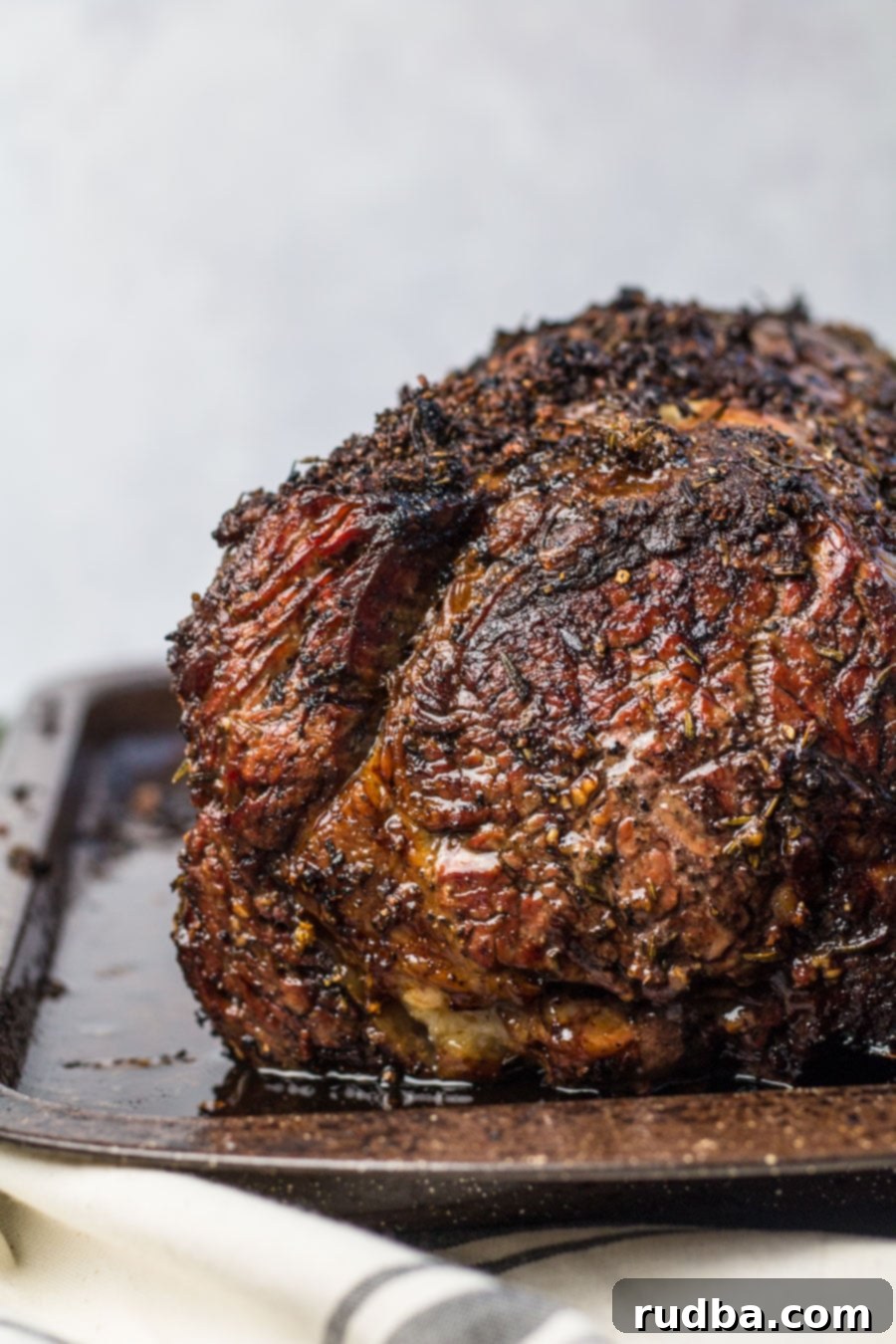

Is Prime Rib the Same as Ribeye?
The distinction between prime rib and ribeye can indeed be a bit confusing, given the multitude of names and cuts in the steak world. To clarify, no, prime rib is not the exact same thing as ribeye. However, they are closely related. A ribeye steak is derived from a prime rib roast. Think of it this way: a prime rib is a large roast, a significant chunk of beef that is typically cooked whole. If that prime rib roast is expertly cut into individual, thick steaks before or after cooking, those individual steaks are what we call ribeye steaks. Both cuts originate from the same area of the animal – the rib primal section. The primary differences lie in the form of the cut (a large roast vs. individual steaks) and their typical preparation methods. Prime rib is generally slow-roasted, while ribeye steaks are often grilled, pan-seared, or broiled.
What is the Best Way to Eat This?
In my experience, the absolute best way to prepare and enjoy prime rib is by slow-roasting it in the oven. This method is by far the most popular and yields the most tender and flavorful results. I always aim to cook my prime rib until its internal temperature doesn’t exceed 120 degrees F before resting. This ensures a perfect medium-rare doneness, where the meat is beautifully pink and exceptionally juicy. Any warmer, and you risk drying out the meat, losing that coveted tenderness. Once it’s perfectly prepared and rested, I love to serve it simply, alongside a selection of delightful side dishes. Of course, everyone has their own preferences, but this method consistently delivers an unparalleled prime rib experience.
How Much Prime Rib Per Person?
When planning your meal, it’s helpful to estimate the right amount of prime rib per guest. A general guideline is to plan for about 1/2 to 3/4 pound per person. If you’re serving other main dishes like turkey or ham alongside the prime rib, you can lean towards the lower estimate of 1/2 pound per person. However, if prime rib is the star and only meat offering, it’s safer to aim for 3/4 pound per person to ensure everyone gets a generous serving. Remember, these are estimates, and appetites vary greatly depending on the individual and the occasion.
How Long Does it Take to Cook a 12 lb Roast?
Cooking times for prime rib can vary significantly based on factors like oven calibration, the roast’s starting temperature, and its shape. While a rough estimate is 15-20 minutes per pound, the most critical tool for perfect doneness is a good meat thermometer. It’s also crucial to remember that the roast will continue cooking and its internal temperature will rise by several degrees once it’s removed from the oven and allowed to rest (this is known as “carryover cooking”). Below are the target temperatures you’ll want to reach *before* removing the prime rib from the oven, keeping carryover cooking in mind:
- Medium Rare – Remove at 110 degrees F (will rise to 125-130 F after resting)
- Medium – Remove at 120 degrees F (will rise to 135-140 F after resting)
- Medium Well – Remove at 130 degrees F (will rise to 145-150 F after resting)
- Well Done – Remove at 140 degrees F (will rise to 155-160 F after resting)
Always err on the side of undercooking slightly, as you can always put the roast back in the oven, but you can’t reverse an overcooked prime rib!
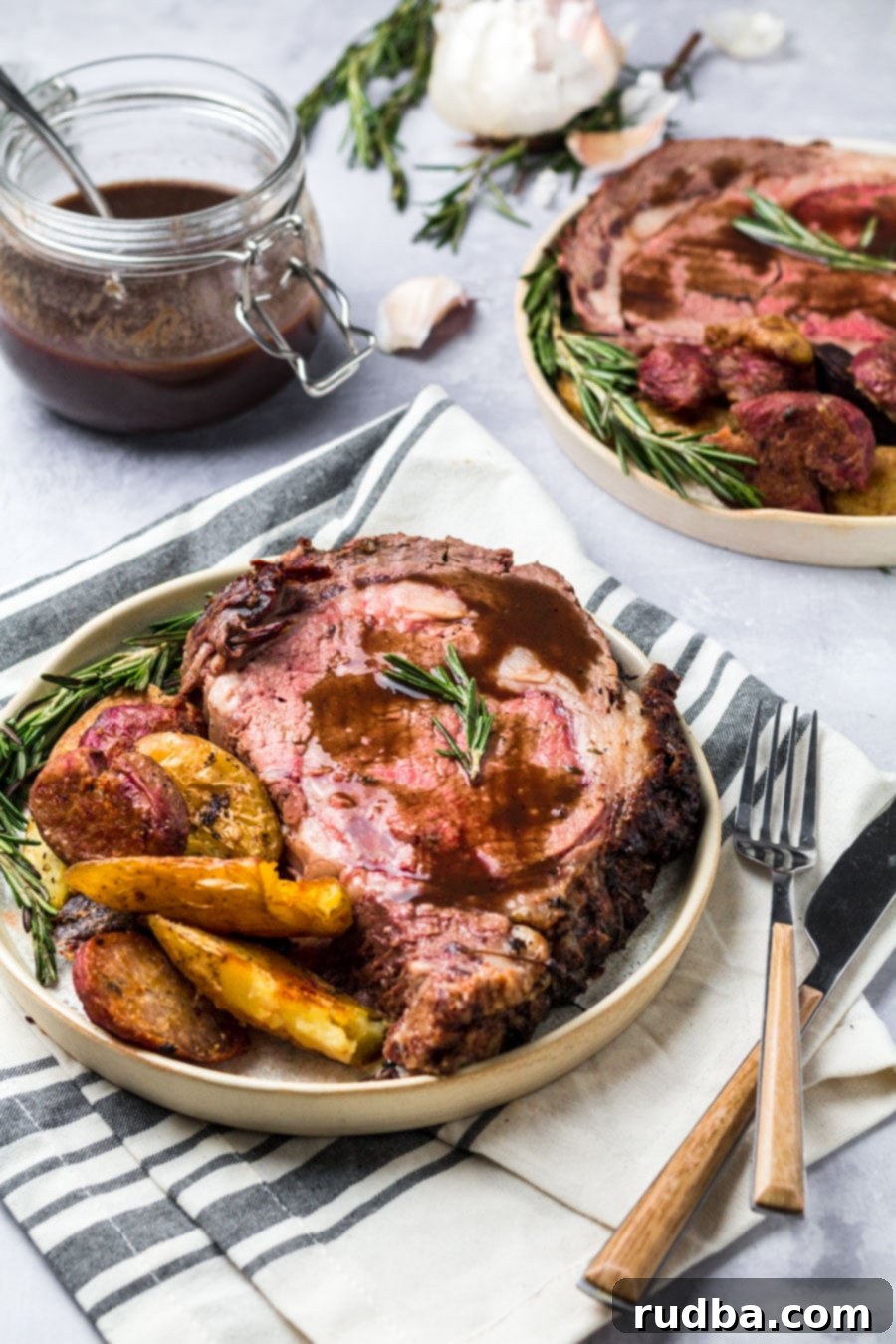
Top Tip: For the most authentic and robust flavor, always use a high-quality meat thermometer to ensure precise doneness, and opt for fresh garlic instead of the pre-minced jarred variety. The difference in taste and aroma is truly remarkable.
I sincerely hope you cherish this classic holiday dinner as much as I do! While it’s a staple for festive occasions, don’t hesitate to enjoy this magnificent meal year-round. It’s truly a dish that brings people together and creates lasting memories.
More Delicious Holiday Recipes You’ll Love…
- Baked Ham with Brown Sugar Glaze
- Juicy Roast Turkey
- Maple Roasted Turkey Breast
- Honey Baked Turkey Wings
For more delectable recipes and step-by-step cooking tutorial videos, be sure to visit my channels on Youtube and Facebook. Happy cooking!
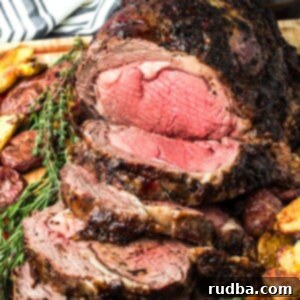
Prime Rib with Au Jus
Save RecipeSaved Recipe
Pin Recipe
Rate Recipe
Print Recipe
Equipment
-
Meat Thermometer
-
Deep Baking Dish
Ingredients
- 12 lbs bone-in prime rib
- 1/2 cup unsalted butter
- 8 cloves garlic, minced
- 2 tbsp fresh thyme, minced
- 2 tbsp fresh rosemary , minced
- 2 1/2 tbsp salt, or to taste
- 3 tsp black pepper, or to taste
Au Jus
- 3 cups drippings , or beef stock
- 2 cups red wine
- 1 tbsp cornstarch
- 1 tbsp water
- 10 roasted garlic cloves
- salt and pepper to taste
Roasted Garlic
- 1 head garlic
- 1/2 tbsp olive oil
- 1/2 tsp salt
- 1/4 tsp black pepper
Instructions
-
How to roast the garlic: Preheat the oven to 400 degrees F. Cut the top off the garlic and place it on aluminum foil. Drizzle with olive oil and season with salt and pepper. Wrap the foil and bake for 25-30 minutes or until the garlic is tender. Keep it wrapped in foil and set aside.
-
Let the rib roast rest on the counter for 30 minutes while you roast the garlic. Once the garlic is done roasting, increase the oven to 500 degrees F.
-
Mix together the softened butter, garlic, thyme, rosemary, salt, and pepper. Thoroughly coat the rib roast with the mixture.
-
Place a thermometer in the meat, place it in a proper deep dish, and cook for 15 minutes. Reduce heat to 325 degrees. Roast until it’s 5 degrees from your desired temperature. Mine took about 4 1/2 hours. Although I highly recommend checking the temperature at around the 4 1/2 hour mark.
-
Remove the meat from the oven and wrap it in foil. Let it rest for 20 minutes while you prepare the au jus.
-
How to make the au jus: Place a skillet over high heat with the pan juices or beef stock (about 2-3 cups) and roasted garlic cloves. Add the wine. Bring to a fast simmer until the liquid has reduced by half.
-
In a small bowl mix the water and cornstarch. Reduce the heat and add the cornstarch mixture to the pan. Whisk constantly. Wait for it to thicken and season with salt and pepper.
-
Slice the prime rib and serve with the au jus. Enjoy!
Notes
- Medium Rare – 110 degrees
- Medium – 120 degrees
- Medium Well – 130 degrees
- Well Done – 140 degrees
Nutrition
Nutrition information is automatically calculated, so should only be used as an approximation.
Additional Info
Like this recipe? Leave a comment below!
